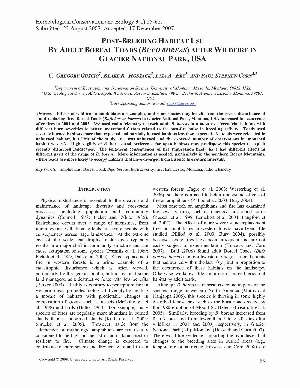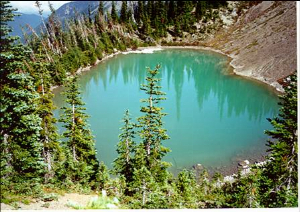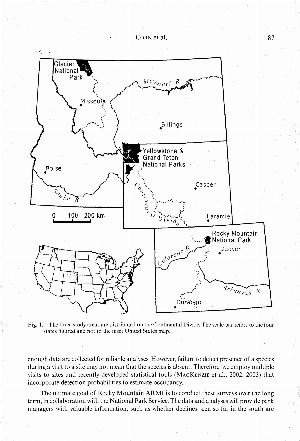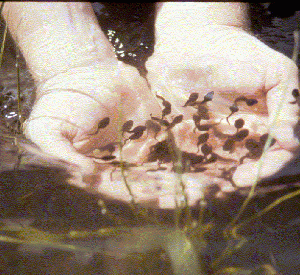Search ARMI Database
Search term(s)
Contribution Number
Search Results
146 record(s) found.
Papers & Reports Amphibians and wildfire in the U.S. Northwest
Authors: Blake R Hossack
Date: 2006 | Outlet: International Journal of Wilderness 12: 26, 43
Scientists are in the early stages of determining the relationship between wildfire and conservation of amphibians in the Northwest. It will not be surprising if we find that amphibian communities are healthier in areas where fire regimes more closely resemble those prior to European settlement, similar to the relationship between wildfire and amphibians in the Southeast. Also, because fire has often been managed differently in wilderness and national parks during the last 30 years or so, compared to actively managed forests, protected lands may be important to the conservation of many amphibians.
Papers & Reports Post-breeding habitat use by adult boreal toads (Bufo boreas boreas) after wildfire in Glacier National Park, USA
Authors: C G Guscio; Blake R Hossack; Lisa A Eby; P. Stephen Corn
Date: 2008 | Outlet: Herpetological Conservation and Biology 3: 55–62
Effects of wildfire on amphibians are complex, and some species may benefit from the severe disturbance of stand-replacing fire. Boreal Toads (Bufo boreas boreas) in Glacier National Park, Montana, USA increased in occurrence after fires in 2001 and 2003. We used radio telemetry to track adult B. boreas in a mosaic of terrestrial habitats with different burn severities to better understand factors related to the post-fire pulse in breeding activity. Toads used severely burned habitats more than expected and partially burned habitats less than expected. No toads were relocated in unburned habitat, but little of the study area was unburned and the expected number of observations in unburned habitat was < 3. High vagility of B. boreas and preference for open habitats may predispose this species to exploit recently disturbed landscapes. The long-term consequences of fire suppression likely have had different effects in different parts of the range of B. boreas. More information is needed, particularly in the northern Rocky Mountains, where toads are more likely to occupy habitats that have diverged from historic fire return intervals.
Papers & Reports Estimated ultraviolet radiation doses in wetlands in six national parks
Authors: S Diamond; P Trenham; Michael J Adams; Blake R Hossack; Roland A Knapp; S L Stark; David F Bradford; P. Stephen Corn; K Czarnowski; Paul D Brooks; D Fagre; Bob Breen; N E Detenbeck; K A Tonnessen
Date: 2005-07-31 | Outlet: Ecosystems 8: 462–477
Ultraviolet-B radiation (UV-B, 280 nm to 320 nm wavelengths) doses were estimated for 1024 wetlands in six National Parks; Acadia (Acadia), Glacier (Glacier), Great Smoky Mountains (Smoky), Olympic (Olympic), Rocky Mountain (Rocky), and Sequoia/Kings Canyon (Sequoia/Kings). Estimates were made using ground-based UV-B data (Brewer spectrophotometers), solar radiation models, GIS tools, field characterization of vegetative features, and quantification of DOC concentration and spectral absorbance. UV-B dose estimates were made for the summer solstice, at a depth of 1 cm in each wetland. Mean dose across all wetlands and parks was 19.3 Whr*m-2 (range of 3.4 to 32.1 Whr*m-2). Mean dose was lowest in Acadia (13.7 Whr*m-2) and highest in Rocky (24.4 Whr*m-2). Doses were significantly different among all parks. These wetland doses correspond to UV-B flux of 125.0 W*cm-2 (range of 21.4 to 194.7 W*cm-2) based on a day length, averaged among all parks, of 15.5 hr. Dissolved organic carbon (DOC), a key determinant of subsurface UV-B flux, ranged from 0.6 (analytical detection limit) to 36.7 mg carbon * l-1 over all wetlands and parks, and reduced potential maximal UV-B doses at 1 cm depth by 1 to 87 %. DOC concentration, as well as its effect on dose, was lowest in Sequoia/Kings, and highest in Acadia (DOC was equivalent in Acadia, Glacier, and Rocky). Landscape reduction of potential maximal UV-B doses ranged from zero to 77 %, and was lowest in Sequoia/Kings. These regional differences in UV-B wetland dose illustrate the importance of considering all aspects of exposure in evaluating the potential impact of UV-B on aquatic organisms.
Papers & Reports Status of amphibians on the Continental Divide: surveys on a transect from Montana to Colorado, USA
Authors: P. Stephen Corn; Blake R Hossack; Erin Muths; Debra A Patla; Charles R Peterson; A L Gallant
Date: 2005 | Outlet: Alytes 22: 85–94
The Rocky Mountain Region of the United States Geological Survey’s Amphibian Research and Monitoring Initiative is conducting monitoring of the status of amphibians on a transect that extends along the Continental Divide from Canada to Colorado and comprises four National Parks. Monitoring uses visual encounter surveys to determine site occupancy, with multiple visits to a subset of sites to estimate detection probabilities for each species. Detection probabilities were generally high (above 0.65) among species. There was a gradient in site occupancy, with most species scarce in the south and relatively common in the north. For example, Bufo boreas is close to extinction in Rocky Mountain National Park, was found at fewer than 5 % of sites in Yellowstone and Grand Teton National Parks in the middle of the transect, but occurs at approximately 10 % of sites in Glacier National Park. The salamander Ambystoma tigrinum was rare in Rocky Mountain and occurred at less than 25 % of sites at Yellowstone and Grand Teton, but A. macrodactylum occurred at more than 50 % of sites in Glacier. There are numerous differences among parks, such as latitude, climate, numbers of visitors, and human population density in the surrounding landscape. The degree to which these factors have influenced the current distribution and abundance of amphibians is unknown but should be a focus of additional research.
Papers & Reports Spatial and temporal variability in the amount and source of dissolved organic carbon: implications for UV exposure in amphibian habitats
Authors: Paul D Brooks; C M O’Reilly; S Diamond; D H Campbell; Roland A Knapp; David F Bradford; P. Stephen Corn; Blake R Hossack; K A Tonnessen
Date: 2005 | Outlet: Ecosystems 8: 478–487
The amount, chemical composition, and source of dissolved organic carbon (DOC), together with in situ ultraviolet (UV-B) attenuation, were measured at 1–2 week intervals throughout the summers of 1999, 2000, and 2001 at four sites in Rocky Mountain National Park (Colorado). Eight additional sites, four in Sequoia and Kings Canyon National Park/John Muir Wilderness (California)and four in Glacier National Park (Montana), were sampled during the summer of 2000.
Papers & Reports Distribution patterns of lentic-breeding amphibians in relation to ultraviolet radiation exposure in western North America
Authors: Michael J Adams; Blake R Hossack; Roland A Knapp; P. Stephen Corn; S Diamond; P Trenham; D Fagre
Date: 2005 | Outlet: Ecosystems 8: 488-500
An increase in ultraviolet-B (UV-B) radiation has been posited as one potential factor in some amphibian population declines. This hypothesis has received support from laboratory and field experiments showing that current levels of UV-B can cause embryo mortality in some species, but little research has addressed whether UV-B is influencing the distribution of amphibian populations. We compared patterns of amphibian presence to site-specific estimates of UV-B dose at 683 ponds and lakes in Glacier, Olympic, and Sequoia-Kings Canyon National Parks. All three parks are located in western North America, a region with a concentration of documented amphibian declines. Site-specific daily UV-B dose was estimated using modeled and field-collected data to incorporate effects of elevation, landscape, and water column dissolved organic carbon. Of the eight species we examined (Ambystoma gracile, Ambystoma macrodactylum, Bufo boreas, Pseudacris regilla, Rana cascadae, Rana leuteiventris, Rana muscosa, Taricha granulosa), two species (T. granulosa and A. macrodactylum) had quadratic relationships with UV-B that could have resulted from negative UV-B effects. Both species were most likely to occur at moderate UV-B levels. Ambystoma macrodactylum only showed this pattern in Glacier National Park. Occurrence of A. macrodactylum increased as UV-B increased in Olympic National Park despite UV-B levels similar to those recorded in Glacier. We also found marginal support for a negative association with UV-B for P. regilla in one of the two parks where it occurred. We did not find evidence of a negative UV-B effect for any other species. Much more work will be necessary to determine if UV-B, either alone or in concert with other factors, is causing widespread population losses in amphibians.




